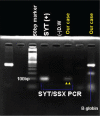Biphasic synovial sarcoma with a striking morphological divergence from the main mass to lymph node metastasis: A case report
- PMID: 35029897
- PMCID: PMC8735718
- DOI: 10.1097/MD.0000000000028481
Biphasic synovial sarcoma with a striking morphological divergence from the main mass to lymph node metastasis: A case report
Abstract
Rationale: Synovial sarcoma accounts for 5% to 10% of all soft tissue sarcomas and involves almost any anatomic site, particularly the deep soft tissue of the extremities of young adults. The incidence rate of lymph node metastases in synovial sarcoma is 3% to 7%, but the detailed morphological features of the metastatic tumors in the lymph node have not been documented.
Patient concerns: A 64-year-old Korean man presented with a huge mass in the left lower thorax and multiple hypermetabolic lymph nodes along the mediastinal, supraclavicular, internal mammary, and retrocrural regions.
Diagnoses: The patient was diagnosed with primary pleuropulmonary biphasic synovial sarcoma with lymph node metastases, where the main mass mostly comprised spindle cells (>95%) and the metastatic lymph nodes comprised only epithelial cells.
Interventions: Left lower lobe lobectomy with the resection of the chest wall (including left ribs 8-10) and diaphragm and mediastinal lymph node dissection were performed.
Outcomes: In the 2-month follow-up period, there have been no complications so far, and the attending physician is currently planning for the adjuvant chemotherapy.
Lessons: The main mass and the metastatic lesion can be clearly different morphologically. In tumors with biphasic differentiation, such as synovial sarcoma, cells that constitute only a small fraction of the main mass may appear as the dominant cells in metastatic lesions.
Copyright © 2022 the Author(s). Published by Wolters Kluwer Health, Inc.
Conflict of interest statement
The author has no conflicts of interest to disclose.
Figures



Similar articles
-
Synovial Sarcoma Is Not Associated With a Higher Risk of Lymph Node Metastasis Compared With Other Soft Tissue Sarcomas.Clin Orthop Relat Res. 2018 Mar;476(3):589-598. doi: 10.1007/s11999.0000000000000057. Clin Orthop Relat Res. 2018. PMID: 29529647 Free PMC article.
-
Metastatic synovial sarcoma of the scalp: Case report.Head Neck. 2016 Feb;38(2):E45-8. doi: 10.1002/hed.24122. Epub 2015 Aug 17. Head Neck. 2016. PMID: 25974105
-
Lymphatic dissemination of bone and soft tissue sarcomas: a lymphographic investigation.Acta Radiol Suppl. 1976;349:1-84. Acta Radiol Suppl. 1976. PMID: 206099 Review.
-
Trends of lymph node sampling and metastasis in pediatric and young adult patients with clear cell, epithelioid, and synovial sarcomas.Pediatr Blood Cancer. 2022 Jun;69(6):e29455. doi: 10.1002/pbc.29455. Epub 2021 Dec 22. Pediatr Blood Cancer. 2022. PMID: 35466567
-
Incidence of metastases to lymph nodes from soft-tissue sarcomas.Semin Surg Oncol. 1988;4(1):27-9. doi: 10.1002/ssu.2980040107. Semin Surg Oncol. 1988. PMID: 2832923 Review.
References
Publication types
MeSH terms
LinkOut - more resources
Full Text Sources

